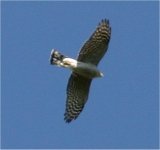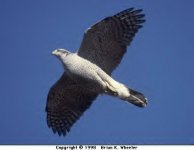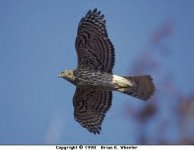-
Welcome to BirdForum, the internet's largest birding community with thousands of members from all over the world. The forums are dedicated to wild birds, birding, binoculars and equipment and all that goes with it.
Please register for an account to take part in the discussions in the forum, post your pictures in the gallery and more.
You are using an out of date browser. It may not display this or other websites correctly.
You should upgrade or use an alternative browser.
You should upgrade or use an alternative browser.
Which hawk is this? (1 Viewer)
- Thread starter teh
- Start date
More options
Who Replied?Michael Frankis
conehead
Davs Thomas,
Ja, jeg tror at det er en Duehøg
Michael
Ja, jeg tror at det er en Duehøg
Michael
Last edited:
Beverlybaynes
Mod Squad
Thomas, I don't think I have seen your posts before, so let me extend you a very warm welcome from the Admin and Mods of BF!
I hope you've added your picture to our galleries -- they are very extensive and your photo will be a happy addition. And the first of many, I hope.
I've not seen a Goshawk yet -- but have a friend who is so fascinated by them he has a "GOSHAWK" vanity plate on his truck!
Michael, I assume that's a 'yes'?
I hope you've added your picture to our galleries -- they are very extensive and your photo will be a happy addition. And the first of many, I hope.
I've not seen a Goshawk yet -- but have a friend who is so fascinated by them he has a "GOSHAWK" vanity plate on his truck!
Michael, I assume that's a 'yes'?
Hi Michael,
I don't speak Danish(although I can guess that "ja" is "yes"!),but I feel that this bird has instant "Goshawk appeal" based on the photo:in particular,the rather full-looking vent,heavy structure,bulging secondaries and rather prominent head point towards Gos.
Harry H
I don't speak Danish(although I can guess that "ja" is "yes"!),but I feel that this bird has instant "Goshawk appeal" based on the photo:in particular,the rather full-looking vent,heavy structure,bulging secondaries and rather prominent head point towards Gos.
Harry H
Michael Frankis
conehead
My thought was probable male, but that's a hunch, not a definitive ident.
Michael
PS Raptor, welcome to the forums!
PPS Harry, translated, my earlier post means 'Yes, I think it is a Goshawk' (Duehøg, = 'dove hawk' in literal translation)
Michael
PS Raptor, welcome to the forums!
PPS Harry, translated, my earlier post means 'Yes, I think it is a Goshawk' (Duehøg, = 'dove hawk' in literal translation)
Well, Ive got to say that I'm not totally convinced that this is a Goshawk. The short neck and very pointed tail corners strongly suggest Sparrowhawk to me and the prominent looking white vent could be the result of lighting effects (the rest of the underparts are in shadow) or the bird might be displaying (Sparrowhawks also fluff up their undertail coverts in display).
The barring on the underwing looks distinctly heavy for an adult Goshawk, especially on the secondaries and I'm not sure that the difference in width between the hand and arm is great enough for Goshawk.
The strongest pro Goshawk feature I can see on this bird is the seemingly short tail but I'm uncertain about how the spread out undertail coverts might be contributing to this.
What was the date when it was photographed Thomas?
Spud
The barring on the underwing looks distinctly heavy for an adult Goshawk, especially on the secondaries and I'm not sure that the difference in width between the hand and arm is great enough for Goshawk.
The strongest pro Goshawk feature I can see on this bird is the seemingly short tail but I'm uncertain about how the spread out undertail coverts might be contributing to this.
What was the date when it was photographed Thomas?
Spud
Sorry to all, I am new to Bird Forums, when it was refered to being a possible Sparrow Hawk, I assumed American Kestral, here in Canada AK is also known as the Sparrow Hawk, now never having seen a Sparrow Hawk I would not know what to look for. I believe your Hobby is more like our American Kestral. so I hope you can forgive me. Raptor.
saluki
Well-known member

Personally, I can't see any markings whatsoever on the underparts. Juvenile gosses look far darker on the underparts than adult birds - and, to me, this bird has a dark front. Also, the sun shining through the primaries indicates brown rather than grey, indicative of a juvenile IMO.
saluki
here's a pic of a juvenile gos in flight
saluki
here's a pic of a juvenile gos in flight
Hello Saluki, I see you use Wheeler / Clark's North America Raptors, it is an excellent reference book, we recommend this book and Hawks in Flight by Dunne, Sibley and Sutton for potential observers at RMERF watch site, the Hawks in Flight is well written and easy to read, it allows one to identify raptors at great distances, Raptor.
Michael Frankis
conehead
Re the date of the photo, if you go to teh's profile page, and from there to his home page, you'll get the date the photo was took, 31/08/2003
http://www.birdwatch.dk/gallery_uk.asp?mode=ShowLarge&ID=255
Is the white tip to the tail of any significance?
Michael
http://www.birdwatch.dk/gallery_uk.asp?mode=ShowLarge&ID=255
Is the white tip to the tail of any significance?
Michael
The white tail tip means that the plumage is fresh but this is apparent from the wings anyway.
I believe that the date given means that the bird cannot be an adult Goshawk as moult of the wings should still be in progress in a bird of that age (and not completed until October). As the bird cannot be a juvenile Gos due to the absence of prominent underpart streaking then it must be a Sparrowhawk. Whether it is an adult or juvenile Sparrowhawk cannot be determined through reference to moult stage as some adult Sparrowhawks (females) may have completed moult by the very end of August.
Spud
I believe that the date given means that the bird cannot be an adult Goshawk as moult of the wings should still be in progress in a bird of that age (and not completed until October). As the bird cannot be a juvenile Gos due to the absence of prominent underpart streaking then it must be a Sparrowhawk. Whether it is an adult or juvenile Sparrowhawk cannot be determined through reference to moult stage as some adult Sparrowhawks (females) may have completed moult by the very end of August.
Spud
Jane Turner
Well-known member
I know its a few months since this was posted... but there isn't a lot of action tonight.
This looks like a Sparrowhawk to me... it just lacks all the hulk-features of Gos. Wing shape, lack of chest...tail shape... mind you I almost never see Goshawks, so perhaps I've forgotten what they look like
Saluki's pics on the other hand shout Gos!
This looks like a Sparrowhawk to me... it just lacks all the hulk-features of Gos. Wing shape, lack of chest...tail shape... mind you I almost never see Goshawks, so perhaps I've forgotten what they look like
Saluki's pics on the other hand shout Gos!
Users who are viewing this thread
Total: 2 (members: 0, guests: 2)







